一、 背景
一般应用对数据库而言都是“读多写少”,也就说对数据库读取数据的压力比较大
主库,负责写入数据,我们称之为:写库;
从库,负责读取数据,我们称之为:读库;
1、 读库和写库的数据一致;
2、 写数据必须写到写库;
3、 读数据必须到读库;
二、 方案
解决读写分离的方案有两种:应用层解决和中间件解决。
2.1、应用层解决
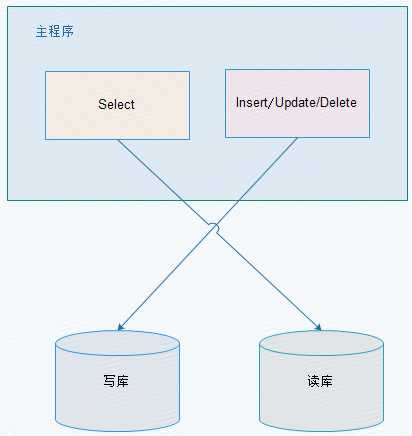
优点:
1、 多数据源切换方便,由程序自动完成;
2、 不需要引入中间件;
3、 理论上支持任何数据库;
缺点:
1、 由程序员完成,运维参与不到;
2、 不能做到动态增加数据源;
2.2、中间件解决
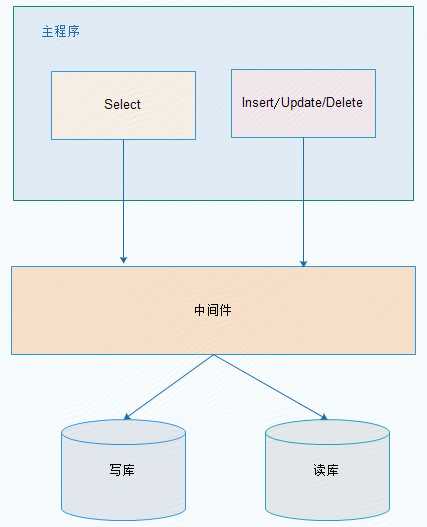
优缺点:
优点:
1、 源程序不需要做任何改动就可以实现读写分离;
2、 动态添加数据源不需要重启程序;
缺点:
1、 程序依赖于中间件,会导致切换数据库变得困难;
2、 由中间件做了中转代理,性能有所下降;
相关中间件产品使用:
mysql-proxy:http://hi.baidu.com/geshuai2008/item/0ded5389c685645f850fab07
Amoeba for MySQL:http://www.iteye.com/topic/188598和http://www.iteye.com/topic/1113437
三、使用Spring基于应用层实现
3.1. 原理
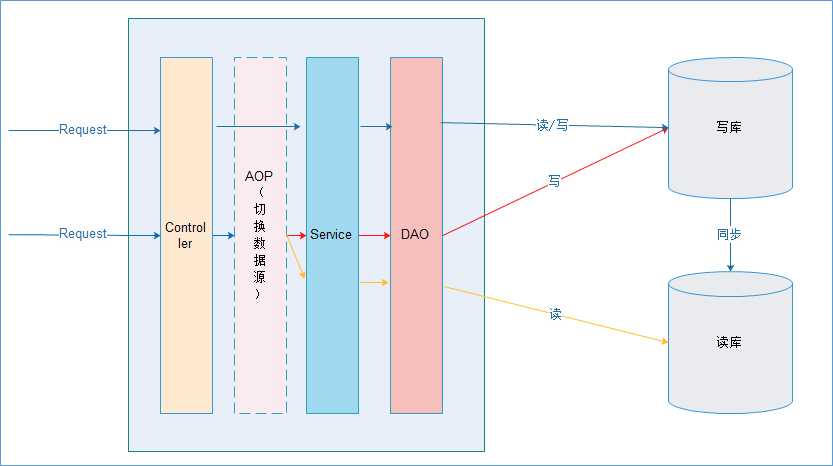
在进入Service之前,使用AOP来做出判断,是使用写库还是读库,判断依据可以根据方法名判断,比如说以query、find、get等开头的就走读库,其他的走写库。
3.2、代码编写
DynamicDataSource

import org.springframework.jdbc.datasource.lookup.AbstractRoutingDataSource; /** * 定义动态数据源,实现通过集成spring提供的AbstractRoutingDataSource,只需要实现determineCurrentLookupKey方法即可 * * 由于DynamicDataSource是单例的,线程不安全的,所以采用ThreadLocal保证线程安全,由DynamicDataSourceHolder完成。 * @since 2018/1/15 17:16 */ public class DynamicDataSource extends AbstractRoutingDataSource { @Override protected Object determineCurrentLookupKey() { // 使用DynamicDataSourceHolder保证线程安全,并且得到当前线程中的数据源key return DynamicDataSourceHolder.getDataSourceKey(); } }
DynamicDataSourceHolder

/** * 使用ThreadLocal技术来记录当前线程中的数据源的key * @since 2018/1/15 17:17 */ public class DynamicDataSourceHolder { //写库对应的数据源key private static final String MASTER = "master"; //读库对应的数据源key private static final String SLAVE = "slave"; //使用ThreadLocal记录当前线程的数据源key private static final ThreadLocal<String> holder = new ThreadLocal<String>(); /** * 设置数据源key * @param key */ public static void putDataSourceKey(String key) { holder.set(key); } /** * 获取数据源key * @return */ public static String getDataSourceKey() { return holder.get(); } /** * 标记写库 */ public static void markMaster(){ putDataSourceKey(MASTER); } /** * 标记读库 */ public static void markSlave(){ putDataSourceKey(SLAVE); } }
DataSourceAspect

import org.apache.commons.lang.StringUtils; import org.aspectj.lang.JoinPoint; /** * @since 2018/1/15 17:18 */ public class DataSourceAspect { /** * 在进入Service方法之前执行 * * @param point 切面对象 */ public void before(JoinPoint point) { // 获取到当前执行的方法名 String methodName = point.getSignature().getName(); if (isSlave(methodName)) { // 标记为读库 DynamicDataSourceHolder.markSlave(); } else { // 标记为写库 DynamicDataSourceHolder.markMaster(); } } /** * 判断是否为读库 * * @param methodName * @return */ private Boolean isSlave(String methodName) { // 方法名以query、find、get开头的方法名走从库 return StringUtils.startsWithAny(methodName, new String[]{"query", "find", "get"}); } }
3.3、配置2个数据源
3.3.1. jdbc.properties

jdbc.master.driver=com.mysql.jdbc.Driver jdbc.master.url=jdbc:mysql://127.0.0.1:3306/mybatis_1128?useUnicode=true&characterEncoding=utf8&autoReconnect=true&allowMultiQueries=true jdbc.master.username=root jdbc.master.password=123456 jdbc.slave01.driver=com.mysql.jdbc.Driver jdbc.slave01.url=jdbc:mysql://127.0.0.1:3307/mybatis_1128?useUnicode=true&characterEncoding=utf8&autoReconnect=true&allowMultiQueries=true jdbc.slave01.username=root jdbc.slave01.password=123456
3.3.2. 定义连接池

<!-- 配置连接池 --> <bean id="masterDataSource" class="com.mchange.v2.c3p0.ComboPooledDataSource" destroy-method="close"> <!-- 数据库驱动 --> <property name="driverClass" value="${jdbc.master.driver}" /> <!-- 相应驱动的jdbcUrl --> <property name="jdbcUrl" value="${jdbc.master.url}" /> <!-- 数据库的用户名 --> <property name="username" value="${jdbc.master.username}" /> <!-- 数据库的密码 --> <property name="password" value="${jdbc.master.password}" /> <!-- 检查数据库连接池中空闲连接的间隔时间,单位是分,默认值:240,如果要取消则设置为0 --> <property name="idleConnectionTestPeriod" value="60" /> <!-- 连接池中未使用的链接较大存活时间,单位是分,默认值:60,如果要永远存活设置为0 --> <property name="idleMaxAge" value="30" /> <!-- 每个分区较大的连接数 --> <property name="maxConnectionsPerPartition" value="150" /> <!-- 每个分区最小的连接数 --> <property name="minConnectionsPerPartition" value="5" /> </bean> <!-- 配置连接池 --> <bean id="slave01DataSource" class="com.mchange.v2.c3p0.ComboPooledDataSource" destroy-method="close"> <!-- 数据库驱动 --> <property name="driverClass" value="${jdbc.slave01.driver}" /> <!-- 相应驱动的jdbcUrl --> <property name="jdbcUrl" value="${jdbc.slave01.url}" /> <!-- 数据库的用户名 --> <property name="username" value="${jdbc.slave01.username}" /> <!-- 数据库的密码 --> <property name="password" value="${jdbc.slave01.password}" /> <!-- 检查数据库连接池中空闲连接的间隔时间,单位是分,默认值:240,如果要取消则设置为0 --> <property name="idleConnectionTestPeriod" value="60" /> <!-- 连接池中未使用的链接较大存活时间,单位是分,默认值:60,如果要永远存活设置为0 --> <property name="idleMaxAge" value="30" /> <!-- 每个分区较大的连接数 --> <property name="maxConnectionsPerPartition" value="150" /> <!-- 每个分区最小的连接数 --> <property name="minConnectionsPerPartition" value="5" /> </bean>
3.3.3. 定义DataSource

<!-- 定义数据源,使用自己实现的数据源 --> <bean id="dataSource" class="cn.lhx.usermanage.spring.DynamicDataSource"> <!-- 设置多个数据源 --> <property name="targetDataSources"> <map key-type="java.lang.String"> <!-- 这个key需要和程序中的key一致 --> <entry key="master" value-ref="masterDataSource"/> <entry key="slave" value-ref="slave01DataSource"/> </map> </property> <!-- 设置默认的数据源,这里默认走写库 --> <property name="defaultTargetDataSource" ref="masterDataSource"/> </bean>
3.4. 配置事务管理以及动态切换数据源切面
3.4.1. 定义事务管理器

<!-- 定义事务管理器 --> <bean id="transactionManager" class="org.springframework.jdbc.datasource.DataSourceTransactionManager"> <property name="dataSource" ref="dataSource" /> </bean>
3.4.2. 定义事务策略

<!-- 定义事务策略 --> <tx:advice id="txAdvice" transaction-manager="transactionManager"> <tx:attributes> <!--定义查询方法都是只读的 --> <tx:method name="query*" read-only="true" /> <tx:method name="find*" read-only="true" /> <tx:method name="get*" read-only="true" /> <!-- 主库执行操作,事务传播行为定义为默认行为 --> <tx:method name="save*" propagation="REQUIRED" /> <tx:method name="update*" propagation="REQUIRED" /> <tx:method name="delete*" propagation="REQUIRED" /> <!--其他方法使用默认事务策略 --> <tx:method name="*" /> </tx:attributes> </tx:advice>
3.4.3. 定义切面

<!-- 定义AOP切面处理器 --> <bean class="cn.lhx.usermanage.spring.DataSourceAspect" id="dataSourceAspect" /> <aop:config> <!-- 定义切面,所有的service的所有方法 --> <aop:pointcut id="txPointcut" expression="execution(* xx.xxx.xxxxxxx.service.*.*(..))" /> <!-- 应用事务策略到Service切面 --> <aop:advisor advice-ref="txAdvice" pointcut-ref="txPointcut"/> <!-- 将切面应用到自定义的切面处理器上,-9999保证该切面优先级较高执行 --> <aop:aspect ref="dataSourceAspect" order="-9999"> <aop:before method="before" pointcut-ref="txPointcut" /> </aop:aspect> </aop:config>
4. 改进切面实现,使用事务策略规则匹配
4.1. 改进后的配置

<!-- 定义AOP切面处理器 --> <bean class="cn.lhx.usermanage.spring.DataSourceAspectTx" id="dataSourceAspectTx"> <!-- 指定事务策略 --> <property name="txAdvice" ref="txAdvice"/> <!-- 指定slave方法的前缀(非必须) --> <property name="slaveMethodStart" value="query,find,get"/> </bean>
4.2. 改进后的实现

import org.apache.commons.lang3.StringUtils; import org.aspectj.lang.JoinPoint; import org.springframework.transaction.interceptor.NameMatchTransactionAttributeSource; import org.springframework.transaction.interceptor.TransactionAttribute; import org.springframework.transaction.interceptor.TransactionAttributeSource; import org.springframework.transaction.interceptor.TransactionInterceptor; import org.springframework.util.PatternMatchUtils; import org.springframework.util.ReflectionUtils; import java.lang.reflect.Field; import java.util.ArrayList; import java.util.List; import java.util.Map; /** * @since 2018/1/15 18:03 */ public class DataSourceAspectTx { private List<String> slaveMethodPattern = new ArrayList<String>(); private static final String[] defaultSlaveMethodStart = new String[]{ "query", "find", "get" }; private String[] slaveMethodStart; /** * 读取事务管理中的策略 * * @param txAdvice * @throws Exception */ @SuppressWarnings("unchecked") public void setTxAdvice(TransactionInterceptor txAdvice) throws Exception { if (txAdvice == null) { // 没有配置事务管理策略 return; } //从txAdvice获取到策略配置信息 TransactionAttributeSource transactionAttributeSource = txAdvice.getTransactionAttributeSource(); if (!(transactionAttributeSource instanceof NameMatchTransactionAttributeSource)) { return; } //使用反射技术获取到NameMatchTransactionAttributeSource对象中的nameMap属性值 NameMatchTransactionAttributeSource matchTransactionAttributeSource = (NameMatchTransactionAttributeSource) transactionAttributeSource; Field nameMapField = ReflectionUtils.findField(NameMatchTransactionAttributeSource.class, "nameMap"); nameMapField.setAccessible(true); //设置该字段可访问 //获取nameMap的值 Map<String, TransactionAttribute> map = (Map<String, TransactionAttribute>) nameMapField.get(matchTransactionAttributeSource); //遍历nameMap for (Map.Entry<String, TransactionAttribute> entry : map.entrySet()) { if (!entry.getValue().isReadOnly()) {//判断之后定义了ReadOnly的策略才加入到slaveMethodPattern continue; } slaveMethodPattern.add(entry.getKey()); } } /** * 在进入Service方法之前执行 * * @param point 切面对象 */ public void before(JoinPoint point) { // 获取到当前执行的方法名 String methodName = point.getSignature().getName(); boolean isSlave = false; if (slaveMethodPattern.isEmpty()) { // 当前Spring容器中没有配置事务策略,采用方法名匹配方式 isSlave = isSlave(methodName); } else { // 使用策略规则匹配 for (String mappedName : slaveMethodPattern) { if (isMatch(methodName, mappedName)) { isSlave = true; break; } } } if (isSlave) { // 标记为读库 DynamicDataSourceHolder.markSlave(); } else { // 标记为写库 DynamicDataSourceHolder.markMaster(); } } /** * 判断是否为读库 * * @param methodName * @return */ private Boolean isSlave(String methodName) { // 方法名以query、find、get开头的方法名走从库 return StringUtils.startsWithAny(methodName, getSlaveMethodStart()); } /** * 通配符匹配 * * Return if the given method name matches the mapped name. * <p> * The default implementation checks for "xxx*", "*xxx" and "*xxx*" matches, as well as direct * equality. Can be overridden in subclasses. * * @param methodName the method name of the class * @param mappedName the name in the descriptor * @return if the names match * @see org.springframework.util.PatternMatchUtils#simpleMatch(String, String) */ protected boolean isMatch(String methodName, String mappedName) { return PatternMatchUtils.simpleMatch(mappedName, methodName); } /** * 用户指定slave的方法名前缀 * @param slaveMethodStart */ public void setSlaveMethodStart(String[] slaveMethodStart) { this.slaveMethodStart = slaveMethodStart; } public String[] getSlaveMethodStart() { if(this.slaveMethodStart == null){ // 没有指定,使用默认 return defaultSlaveMethodStart; } return slaveMethodStart; } }
5. 一主多从的实现
很多实际使用场景下都是采用“一主多从”的架构的,所有我们现在对这种架构做支持,目前只需要修改DynamicDataSource即可。
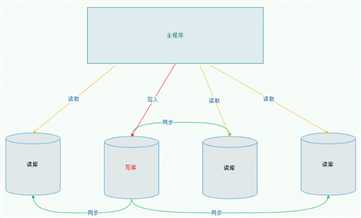
实现没有校验:

package com.jd.ofc.trace.common.datasource; import org.slf4j.Logger; import org.slf4j.LoggerFactory; import org.springframework.jdbc.datasource.lookup.AbstractRoutingDataSource; import org.springframework.util.ReflectionUtils; import javax.sql.DataSource; import java.lang.reflect.Field; import java.util.ArrayList; import java.util.List; import java.util.Map; import java.util.concurrent.atomic.AtomicInteger; /** * @author lihongxu6 * @since 2018/1/16 15:07 */ public class DynamicDataSourceMutliSlave extends AbstractRoutingDataSource { private static final Logger LOGGER = LoggerFactory.getLogger(DynamicDataSource.class); private Integer slaveCount; // 轮询计数,初始为-1,AtomicInteger是线程安全的 private AtomicInteger counter = new AtomicInteger(-1); // 记录读库的key private List<Object> slaveDataSources = new ArrayList<Object>(0); @Override protected Object determineCurrentLookupKey() { // 使用DynamicDataSourceHolder保证线程安全,并且得到当前线程中的数据源key if (DynamicDataSourceHolder.isMaster()) { Object key = DynamicDataSourceHolder.getDataSourceKey(); if (LOGGER.isDebugEnabled()) { LOGGER.debug("当前DataSource的key为: " + key); } return key; } Object key = getSlaveKey(); if (LOGGER.isDebugEnabled()) { LOGGER.debug("当前DataSource的key为: " + key); } return key; } @SuppressWarnings("unchecked") @Override public void afterPropertiesSet() { super.afterPropertiesSet(); // 由于父类的resolvedDataSources属性是私有的子类获取不到,需要使用反射获取 Field field = ReflectionUtils.findField(AbstractRoutingDataSource.class, "resolvedDataSources"); field.setAccessible(true); // 设置可访问 try { Map<Object, DataSource> resolvedDataSources = (Map<Object, DataSource>) field.get(this); // 读库的数据量等于数据源总数减去写库的数量 this.slaveCount = resolvedDataSources.size() - 1; for (Map.Entry<Object, DataSource> entry : resolvedDataSources.entrySet()) { if (DynamicDataSourceHolder.MASTER.equals(entry.getKey())) { continue; } slaveDataSources.add(entry.getKey()); } } catch (Exception e) { LOGGER.error("afterPropertiesSet error! ", e); } } /** * 轮询算法实现 * * @return */ public Object getSlaveKey() { // 得到的下标为:0、1、2、3…… Integer index = counter.incrementAndGet() % slaveCount; if (counter.get() > 9999) { // 以免超出Integer范围 counter.set(-1); // 还原 } return slaveDataSources.get(index); } }
四、MySQL主从复制
4.1、原理

mysql主(称master)从(称slave)复制的原理:
1、master将数据改变记录到二进制日志(binary log)中,也即是配置文件log-bin指定的文件(这些记录叫做二进制日志事件,binary log events)
2、slave将master的binary log events拷贝到它的中继日志(relay log)
3、slave重做中继日志中的事件,将改变反映它自己的数据(数据重演)
4.2、主从配置需要注意的地方
1、主DB server和从DB server数据库的版本一致
2、主DB server和从DB server数据库数据一致[ 这里就会可以把主的备份在从上还原,也可以直接将主的数据目录拷贝到从的相应数据目录]
3、主DB server开启二进制日志,主DB server和从DB server的server_id都必须唯一
4.3、主库配置(windows,Linux下也类似)
在my.ini修改:

#开启主从复制,主库的配置 log-bin = mysql3306-bin #指定主库serverid server-id=101 #指定同步的数据库,如果不指定则同步全部数据库 binlog-do-db=mybatis_1128
执行SQL语句查询状态:
SHOW MASTER STATUS

需要记录下Position值,需要在从库中设置同步起始值。
4.4、在主库创建同步用户
#授权用户slave01使用123456密码登录mysql
grant replication slave on *.* to ‘slave01‘@‘127.0.0.1‘ identified by ‘123456‘;
flush privileges;
4.5、从库配置
在my.ini修改:
#指定serverid,只要不重复即可,从库也只有这一个配置,其他都在SQL语句中操作
server-id=102
以下执行SQL:
CHANGE MASTER TO
master_host=‘127.0.0.1‘,
master_user=‘slave01‘,
master_password=‘123456‘,
master_port=3306,
master_log_file=‘mysql3306-bin.000006‘,
master_log_pos=1120;
#启动slave同步
START SLAVE;
#查看同步状态
SHOW SLAVE STATUS;
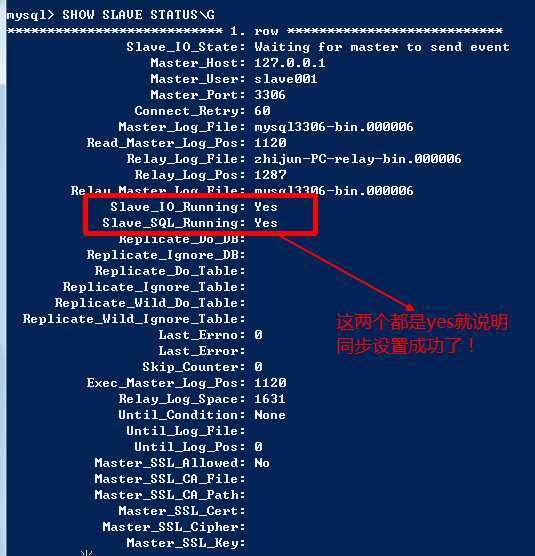
原文地址:http://blog.csdn.net/zbw18297786698/article/details/54343188

